Acylindrical Lenses
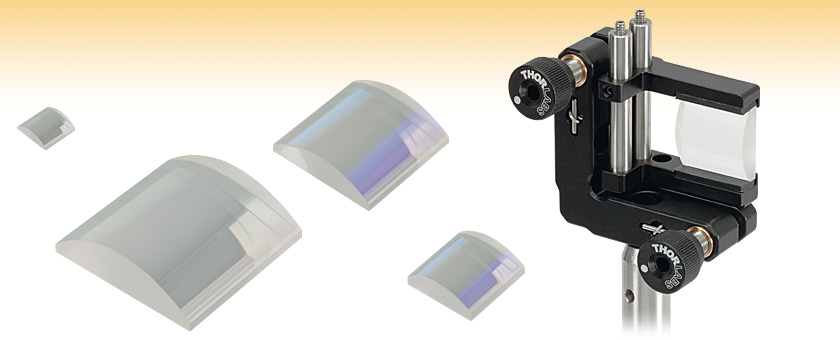
- Cylindrical Lenses Designed to Minimize Aberrations
- Focal Lengths Ranging from 8.00 mm to 40.00 mm
- Two AR Coatings Available
AYL108-A
AYL5040-A
AYL3026-B
AYL2018-B
AYL2018-A
Mounted in a
KM100C Kinematic
Cylindrical Lens Mount

Please Wait
| Table 1.1 General Specifications | |
|---|---|
| Design Wavelength | 780 nm |
| AR Coating Range | 350 - 700 nm (-A Coating) 650 - 1050 nm (-B Coating) |
| Wavefront Error (RMS) | <0.5 µm |
| Surface Quality | 60-40 Scratch-Dig |
| Lens Material | S-LAH64 |
| Index of Refraction at 780 nm | 1.777 |
| Abbe Number | 47.3 |
| Table 1.2 Precision Aspheric Lenses Selection Guide | ||
|---|---|---|
| Substrate Material | NA | Mount |
| UV Fused Silica | 0.142 - 0.145 | Unmounted |
| 0.142 - 0.145 | Mounted | |
| 0.65 | Unmounted | |
| N-BK7 / S-LAH64 | 0.23 - 0.61 | Unmounted |
| 0.23 - 0.55 | Mounted | |
| Zinc Selenide | 0.22 - 0.67 | Unmounted |
| Acylindrical Lenses | 0.45 - 0.54 | Unmounted |
| Axicons | - | Unmounted |
| Click on the red Document icon next to the item numbers below to access the Zemax file download. Our entire Zemax Catalog is also available. |
Features
- Cylindrical Lenses Featuring an Aberration-Reducing Acylindrical Surface
- Numerical Apertures Ranging from 0.45 to 0.54
- Available with Either a 350 - 700 nm or 650 - 1050 nm AR Coating
These acylindrical lenses are the cylindrical counterpart to an aspheric lens; they are designed to combine the aberration-reducing benefits of an aspheric surface with the one-dimensional focusing of a standard cylindrical lens. The lenses sold on this page are manufactured using a computer numerical controlled (CNC) grinding and polishing process.
Positive cylindrical lenses are ideal for applications requiring magnification in one dimension. While spherical lenses act symmetrically in two dimensions on an incident ray, cylindrical lenses act in the same manner but only in one dimension. A typical application is to use a pair of cylindrical lenses to provide anamorphic shaping of a beam. A pair of positive cylindrical lenses can be used to collimate and circularize the output of a laser diode. Another application possibility would be to use a single lens to focus a diverging beam onto a detector array.
These cylindrical lenses are slightly deviated from a true cylinder in a way that minimizes the introduction of aberrations, which yields a wavefront error of 500 nm (RMS). The lenses are manufactured using S-LAH64 optical glass, which is a low-dispersion glass with high index of refraction in order to minimize chromatic aberration.
Please see Table 1.2 for our full selection of precision aspheric lenses.
Mounting Options
These lenses may be mounted in one of our cylindrical lens mounts. For a specific mount recommendation for each lens, please see the Mounting Options tab.
Custom and OEM Acylindrical Lenses
If our standard offerings do not meet the needs of your application, Thorlabs can manufacture custom and OEM acylindrical lenses to your unique specifications. Examples of customization options include but are not limited to:
- Lens Size, Thickness, and Material
- Application of Thorlabs' Antireflective (AR) Coatings
- Fully Custom Lens Design
Whether you need a modified catalog item or a fully customized design, we invite you to contact us to discuss how our extensive in-house manufacturing and customization capabilities can help you achieve your goals.
We look forward to hearing from you!
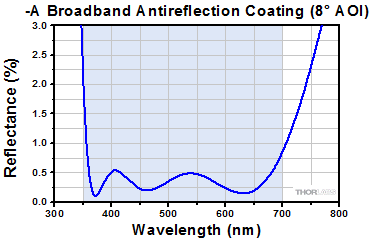
Click to Enlarge
Click Here for Raw Data
The blue shaded region indicates the specified 350 - 700 nm wavelength range for optimum performance.
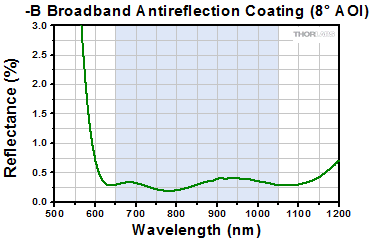
Click to Enlarge
Click Here for Raw Data
The blue shaded region indicates the specified 650 - 1050 nm wavelength range for optimum performance.
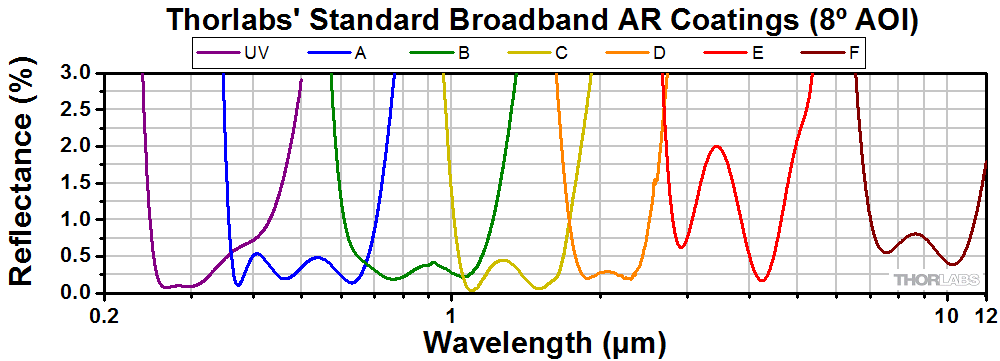
Acylindircal Lens Design Formula
| Definitions of Variables | |
|---|---|
| z | Sag (Surface Profile) as a Function of Y |
| Y | Radial Distance from Optical Axis |
| R | Radius of Curvature |
| k | Conic Constant |
| An | nth Order Acylindric Coefficient |
The acylindric surface of these lenses may be described using a polynomial expansion in Y, the radial distance from the optical axis. The surface profile or sagitta (often abbreviated as sag) is denoted by z, and is given by the following expression:
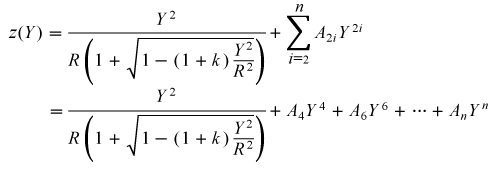
where R is the radius of curvature, k is the conic constant, and the An are the nth order acylindric coefficients. The sign of R is determined by whether the center of curvature for the lens surface is located to the right or left of the lens' vertex; a positive R indicates that the center of curvature is located to the right of the vertex, while a negative R indicates that the center of curvature is located to the left of the vertex. For example, the radius of curvature for the left surface of a biconvex lens would be specified as positive, while the radius of curvature for its right surface would be specified as negative.
Acylindric Lens Coefficients
Due to the mirror symmetry of the lens surface, only even powers of Y are contained in the polynomial expansion above. The target values of the acylindric coefficients for each product can be found in Table 3.2 or by clicking on the red documents icon (![]() ) next to each lens sold below.
) next to each lens sold below.
| Table 3.2 Target Values | ||||||||
|---|---|---|---|---|---|---|---|---|
| Item #a | R (mm) | k | A4 | A6 | A8 | A10 | A12 | A14 |
| AYL108 | 6.215 | -1 | 0.00018680241 | -2.8117704x10-7 | -1.1437438x10-8 | -6.5531277x10-11 | 8.2269606x10-13 | 1.0162473x10-14 |
| AYL1210 | 7.769 | -1 | 0.000103142151 | -3.1487641x10-8 | -2.3956768x10-9 | -1.2553088x10-11 | 2.5966531x10-14 | 9.9276734x10-16 |
| AYL1512 | 9.323 | -1 | 5.6701194x10-5 | -2.9695257x10-8 | -6.7147817x10-10 | -1.9589951x10-12 | 8.2834399x10-15 | 6.1793501x10-17 |
| AYL1815 | 11.653 | -0.541 | -7.5260568x10-6 | -7.2065825x10-8 | -2.7040888x10-10 | -5.5002321x10-13 | - | - |
| AYL2018 | 13.984 | -1 | 1.6224686x10-5 | -5.2804848x10-9 | -3.9073587x10-11 | -4.128074x10-14 | 1.133365x10-16 | 2.5522566x10-19 |
| AYL2520 | 15.538 | -1 | 1.1926075x10-5 | -2.9323497x10-9 | -1.8718889x10-11 | -1.7009961x10-14 | 3.5481542x10-17 | 6.5241296x10-20 |
| AYL3026 | 20.199 | -1 | 5.1910079x10-6 | -1.0272627x10-9 | -3.1622293x10-12 | 7.6437337x10-17 | - | - |
| AYL4532 | 24.86 | -1 | 2.9712681x10-6 | -2.3853122x10-10 | -6.746461x10-13 | -3.7931531x10-16 | 3.8682268x10-19 | - |
| AYL5040 | 31.076 | -1 | 1.4665926x10-6 | -1.0295617x10-10 | -1.4533162x10-13 | -3.0797158x10-17 | 2.0313548x10-20 | 5.5700818x10-24 |
Thorlabs offers kinematic, fixed, and cage-compatible cylindrical lens mounts. Table 4.1 lists a recommended fixed and kinematic mount for our acylindrical lenses.
| Table 4.1 Mounting Options | |||
|---|---|---|---|
| Item # | Kinematic Mount | Fixed Mount | Cage Compatible |
| AYL108 | KM100C or KM100CL | CH1A or CH2B | CYCPA (30 mm) or CYLCPA (60 mm) |
| AYL1210 | KM100C or KM100CL | CH1A or CH2B | CYCPA (30 mm) or CYLCPA (60 mm) |
| AYL1512 | KM100C or KM100CL | CH1A or CH2B | CYCPA (30 mm) or CYLCPA (60 mm) |
| AYL1815 | KM100C or KM100CL | CH1A or CH2B | CYLCPA (60 mm) |
| AYL2018 | KM100C or KM100CL | CH1A or CH2B | CYLCPA (60 mm) |
| AYL2520 | KM100C or KM100CL | CH1A or CH2B | CYLCPA (60 mm) |
| AYL3026 | KM100C or KM100CL | CH1A or CH2B | CYLCPA (60 mm) |
| AYL4532 | - | CH2B | CYLCPA (60 mm) |
| AYL5040 | - | CH2B | - |
| Posted Comments: | |
信安 陳
(posted 2023-09-26 16:06:42.423) 詢 : 以下項目公差
1. 尺寸
2.中心厚度
3.邊緣厚度 cdolbashian
(posted 2023-10-02 04:55:46.0) Thank you for reaching out to us with this inquiry. I have contacted you directly to answer these dimensional-tolerance related inquiries. 201allenchiu
(posted 2018-05-24 01:42:04.357) Dear Thorlabs,
I wonder if your company can help us cut this lens into a 1 inch round version just like LJ1695RM. Thanks
Best,
Allen YLohia
(posted 2018-06-20 01:28:08.0) Hello Allen, thank you for contacting Thorlabs. We will reach out to you directly to discuss your requirements for this. daniel.perezcalero
(posted 2013-03-08 06:59:17.547) Dear Sir,
We are interested in the acquisition of an 8.0 focal length acylinder from your company. The element of interest is the AYL108.
Due to the special application of the system we would like to know if it is possible to acquire such product with two special features:
1- We would require the lens to be uncoated. Is that a possibility?
2- The dimensions of the component is 10mmx10mm. We are currently interested in a longer lens. In fact we would like to have a 25mmx10mm or even longer.
Is it possible to have such component?
Thank you very much and best regards,
Daniel Perez Calero
Optical designer TNO tcohen
(posted 2013-03-14 14:06:00.0) Response from Tim at Thorlabs to Daniel: Thank you for contacting us. We can supply many custom optics. I will get in contact with you directly to discuss your requirements. |


 Products Home
Products Home








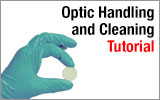

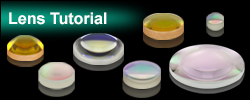

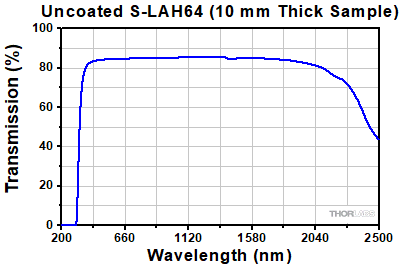
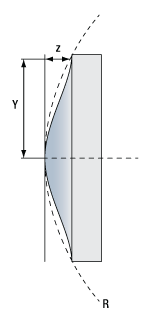
 Acylindrical Lenses
Acylindrical Lenses